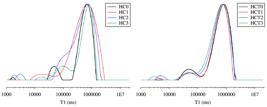In this study, hybrid nanocomposites based on HIPS, high-impact polystyrene, were prepared in chloroform and in a 1:1 mixture of toluene and chloroform varying the quantity of organophilic montmorillonite. The morphology of the hybrid materials was investigated by X-ray diffraction (XRD) and proton relaxometry, determined in a low-field 1H nuclear magnetic resonance (NMR). The thermal characteristics were also obtained through thermogravimetric analysis. The emphasis of this study was to compare the effect of a pair of solvents against a single solvent in the formation/organization of the nanostructured materials when the solution method is applied. It was taken into consideration Interactions involving polymer-solvent, nanoparticle-solvent, and, principally, polymer-nanoparticle-solvent. The results show that the choice of solvent affects greatly the characteristic of the nanocomposites. Nanocomposites prepared with chloroform/toluene were more homogenous, more prone to exfoliate (for all organoclay concentrations), and had higher degradation temperature compared to the materials obtained with chloroform. It is clear from the data that the use of a solvent pair is important to produce good nanocomposites when using the solution method and that the clay proportion plays a role in the dispersion of organoclay in the polymer matrix.
polymer; nanocomposites; HIPS; NMR; relaxometry

 Thumbnail
Thumbnail
 Thumbnail
Thumbnail

